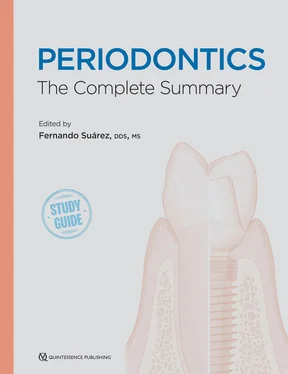The measurement of PDs is considered to be one of the most important parameters of the periodontal examination because it provides an overall assessment of the periodontal pockets, which are usually considered as a critical sign for the establishment of a diagnosis. In addition, pockets are also the major habitats for periodontal pathogens. 3Currently, the most widely used instrument to obtain PDs in clinical practice is the conventional or manual probe. In 1936, periodontist Charles H. M. Williams created the first periodontal probe, and his invention—the Williams periodontal probe—has been the prototype or benchmark for all manual probes. 4Different types of conventional periodontal probes have been developed over the years and utilized for different indications. Box 2-1summarizes the common types of conventional probes used in the clinic and their characteristics and indications. 4
BOX 2-1 Common types of periodontal probes
Williams probe
The graduations on this probe are 1-, 2-, 3-, 5-, 7-, 8-, 9-, and 10-mm. The 4- and 6-mm markings are absent to improve visibility and avoid confusion in reading the markings.
Merritt B probe
The graduations and markings on this probe are the same as Williams probe.
Goldman-Fox probe
This probe has a flattened tip. The graduations and markings on this probe are the same as Williams probe; however, the flat tip end might preclude easy access into tight or narrow pockets.
UNC 15 probe
The graduations on this probe are 1-, 2-, 3-, 4-, 5-, 6-, 7-, 8-, 9-, 10-, 11-, 12-, 13-, 14-, and 15-mm. This probe is color-coded at every millimeter demarcation, and it is suitable for deeper pockets (ie, > 10 mm).
Marquis color-coded probe
The graduations on this probe are 3-, 6-, 9-, and 12-mm. Color markings are darker at 3–6 mm and 9–12 mm. The main disadvantage of this probe is its accuracy; the measurements are usually estimated between color markings.
Michigan O probe
The graduations on this probe are 3-, 6-, and 8-mm and are color-coded. This probe might not be suitable for deeper pockets (ie, > 8 mm), and the measurements are also estimated between color markings.
CPITN probe
The graduations on this probe are 3.5-, 5.5-, 8.5-, and 11.5-mm. Markings are a darker color at 3.5–5.5 mm and 8.5–11.5 mm. This probe is particularly useful for screening and monitoring patients or for epidemiologic research.
UNC, University of North Carolina; CPITN, community periodontal index of treatment needs.
Conventional probes are easily operated and inexpensive; therefore, these are the most commonly used probe system in dental clinics. However, conventional probes also present with several disadvantages 4:
The pressure applied cannot be standardized.
Assistants are often needed to transfer measurements to a periodontal chart.
Operator variability and errors can affect the readings of the markings.
In order to overcome these disadvantages of conventional probes, new generations of probes have been developed. These include but are not limited to the following 4:
Constant-pressure probes: Designed to be pressure sensitive, therefore allowing for standardization of the force applied during PD measurements.
Computer-assisted/automated probes: This generation of probes was developed based on constant-pressure probes. Added features include automated detection of the measurement and computer-assisted data capture into a storage system. This minimizes possible errors from probe reading and data recording.
3D probes: This instrument aims to develop a method to record the PD in a serial matter instead of linear measurements.
Noninvasive probes: Probing into periodontal pockets can often be uncomfortable and/or painful to patients. This probe system is still under development, and it aims to identify the periodontal pocket and attachment level without the need to physically penetrate the tissues.
The usage of these newer probe systems is still very limited due to various considerations such as cost (more expensive), less tactile sensitivity, and less accessibility for most dentists. To date, the conventional periodontal probe is still the most popular system that is used in dental offices when a periodontal examination is performed. 4
It is very important to bear in mind that, when measuring PDs with a conventional probe, there are a number of factors that can affect these measurements and their accuracy. The variables are summarized in Table 2-1. 5–14
TABLE 2-1 Variables affecting probing measurements
| Reproducibility |
Operators’ experience and skills would affect the inter- and intraexaminer reproducibility. |
| Probing force |
Probing force affects how deep the periodontal probes penetrate into the pocket and the connective tissue; greater probing force usually results in deeper PDs. 5It has been recommended that 30 g (0.3 N) of probing force be used during periodontal examination to allow the probe tip to remain within the junctional epithelium. 6,7Probing forces up to 50 g (0.5 N) would penetrate deeper, and the probe tip could reach closer to the alveolar bone. 6,7 |
| Probe angulation |
Mean PDs could be 1 mm greater with midproximal compared to line-angle measurements. 8 |
| Gingiva inflammation |
Periodontal probes tend to penetrate deeper into the gingival tissue when inflammation is present 9–14: |
| Healthy dentition |
Apical one-third of junctional epithelium |
| Gingivitis |
Apical one-third of junctional epithelium |
| Periodontitis |
Coronal one-third of connective tissue |
| Posttreatment periodontitis |
Apical one-third of junctional epithelium |
| Site and local anatomy |
Crown contours, defective restorations and margins, tipped or rotated teeth, osseous ledges, and subgingival calculus can all affect probing accuracy. |
| Type of probe |
Different types of conventional probes, pressure-sensitive probes, and computer-assisted data recording probes could yield different measurements. |
| Natural dentition versus dental implants |
Probing at an implant site usually results in deeper depths compared with probing at a natural tooth 9–14: |
| Healthy implant |
Apical one-third of junctional epithelium to coronal one-third of connective tissue |
| Peri-implant mucositis |
Apical two-thirds of connective tissue |
| Peri-implantitis |
Apical one-third of connective tissue and close proximity to bone |
| Posttreatment peri-implantitis |
Apical two-thirds of connective tissue |
It is also of relevance to differentiate between the terms “pocket depth” and “probing depth.” The measurement obtained with a probe into the gingiva includes not only the depth of the gingival sulcus or periodontal pocket, but also an additional distance that represents varying degrees of adjacent tissue penetration. 15Therefore, the objective when a periodontal probe is inserted into the space between the tooth and the gingiva is to measure the probing depth instead of the anatomical structure of the pocket depth, which can only be accomplished histologically. 2Listgarten also emphasized the use of the correct terminology “probing depth” when describing periodontal probing in the literature. 15
CLINICAL ATTACHMENT LEVEL
The definition of CAL is the distance from the cementoenamel junction (CEJ) to the tip of a periodontal probe during diagnostic periodontal probing. 1The amount of gingival recession is needed to calculate the CAL. Recession by definition is the migration of the gingiva to a point apical to the CEJ, 1and it is often described as the distance between CEJ and the free gingival margin. Recession can be recorded as a positive (+) or negative (–) measurement. Recession is recorded as “+” when CEJ is visible and the free gingival margin is below the CEJ. However, when there is gingival enlargement, recession is recorded as a negative “–” measurement (Fig 2-1). CAL can then be calculated by adding PD and recession (making sure to include “+” or “–”). In Fig 2-1, all four case scenarios measured 6 mm PD; however, when recession is taken into account to determine the CAL, it is clear that the degree of periodontal destruction of these four cases is very different. Therefore, compared with PD, the level of CAL can provide a better overall estimate of the periodontium, and it usually correlates better with radiographic bone loss. 3
Читать дальше












